#Haight Ashbury Portraits
Photo

Linda, Straight Theater, 1968. photo by Elaine Mayes
(photo via: Life in the Haight, 67-68. (Damiani, 2022) @arcanabooks)
The Eve of the Summer of Love - Elaine Mayes on Her Haight ...
#Elaine Mayes#Linda Straight Theater 1968#Haight Ashbury Portraits#Haight-Ashbury Portraits 1967-1968#Books#Photo Books
95 notes
·
View notes
Text
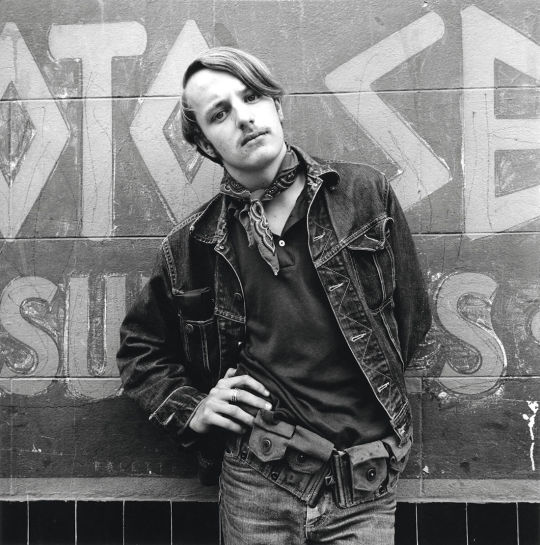
John C. Maynard in front of a drugstore wall, Ashbury Street, San Francisco, 1968 - Elaine Mayes
17 notes
·
View notes
Text
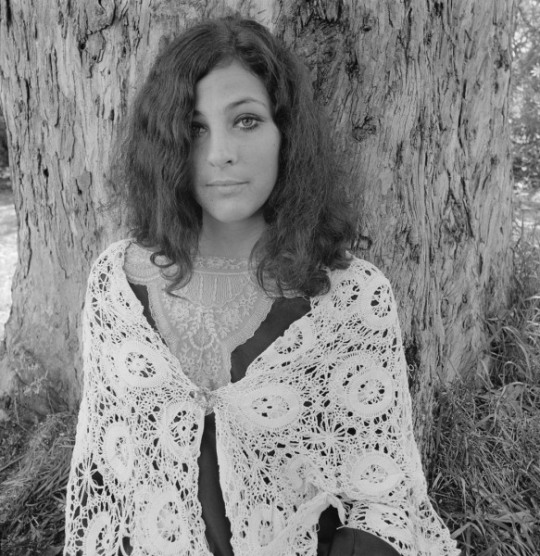
Elaine Mayes: Summer of Love a period of great social, cultural, and political change that brought together over 100,000 like-minded young people to San Francisco to usher in a new era.
The exhibition will feature Mayes’ intimate vintage black and white portraits of youth counterculture in San Francisco’s Haight-Ashbury district during the late 1960’s. The photographs are compelling depictions that are at once specific to the individuals pictured, as well as definers of that age and era. They reveal a freedom of expression and camaraderie that was shared by a generation at odds with its current social ideals. Together with these images will be informal portraits of musicians and festivalgoers.
3 notes
·
View notes
Text

Haight-Ashbury Portrait, Photo by Elaine Mayes, 1967–68
36 notes
·
View notes
Text


Slouching Towards Bethlehem by Joan Didion - 5/5
After enjoying Tove Jansson’s The Summer Book on my trip to the coast, I decided to pack Slouching Towards Bethlehem by Joan Didion to read in San Francisco, because the title essay is a sociocultural exposé of the Haight-Ashbury neighborhood in the 1960s. This was her first essay collection, and I found it a lot stranger than The White Album, perhaps because all of the essays were constrained to just a few years (all from the 1960s, mostly from ’66-’67). Together, the essays form a cohesive portrait of California at a certain point in time, profiling San Francisco, Sacremento, Los Angeles, San Bernardino, and even the West Coast’s relationship to Hawai’i. I describe Didion’s style as meditative, though not in the way you might take that; I don’t mean it’s contemplative, but rather she treats her subjects in the same way that one is supposed to treat thoughts during meditation, letting each pass through without judgement. Everything is just part of the Californian landscape.
Despite the famously heartbreaking titular essay, other parts of Slouching Towards Bethlehem had me laughing out loud. Didion presents idealist communists who talk about depression being an “impediment to the revolutionary process”, but also mocks the other side, Christians who feel threatened by hippies doing yoga in their neighborhoods. In some essays we even gain a little insight into Didion’s own literary persona, like in the closer “Goodbye to All That,” in which she discusses her depression from living in New York. I find it futile to choose favorites from this collection, because it worked so well as a whole, and I would be doing it a disservice to recommend anything other than reading it in entirety.
#Joan Didion#Slouching Towards Bethlehem#essays#nonfiction#may 2023#2023#5#I POSTED THIS TO THE WRONG GOTDAM BLOG
3 notes
·
View notes
Photo

Photos from 'Elaine Mayes: The Haight-Ashbury Portraits 1967–1968' on view now at @deborahbellphotographs and published by @damiani_books If you're in NYC today, January 21 at 3 PM, please join the photographer and editor Kevin Moore for a discussion of the exhibition and book, followed by a reception and book signing. If you are unable to attend in person, the event will be recorded and available later for viewing via the gallery. Deborah Bell Photographs 526 West 26th Street, Room 411 New York, NY 10001 Phone: 212.249.9400 Email: [email protected] #elainemayes @elainemayesphoto @fultonstreet #haightashbury https://www.instagram.com/p/CnsGBbyJdM7/?igshid=NGJjMDIxMWI=
0 notes
Text
The quarter is almost done - and the semester in turn. Make sure you are on top of ALL the work you are currently on and that you SIGN UP FOR ET when you need to.
The quarter is almost done – and the semester in turn. Make sure you are on top of ALL the work you are currently on and that you SIGN UP FOR ET when you need to.
Intro to Painting – Portrait Paintings
Karen Kilimnik – “Me, Corner of Haight and Ashbury” 1966, 1998
Let’s read about the periods you are working on… Based on my memories we have…
Renaissance
Realism
Surrealism
pop
Neo-Expressionism
If I have missed any – visit TATE Art Terms to look your up and read about it.
Art Foundations – METALS and COLLAGE!
What was your MOTIF for NATURE?
How…

View On WordPress
0 notes
Photo
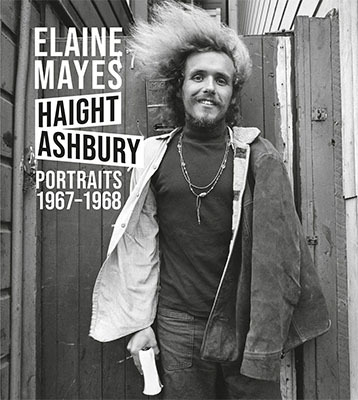
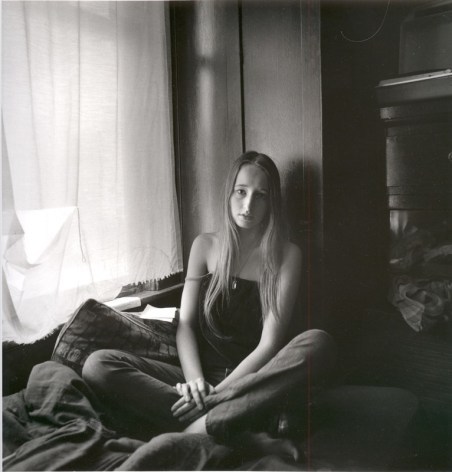


BOOK REVIEW: HAIGHT-ASHBURY PORTRAITS 1967-1968 by Elaine Mayes (2022)
HAIGHT-ASHBURY features more than 40 black & white portrait photographs capturing a distinct district of San Francisco, California at the HEIGHT of hippiness; that’s the height (and length) of hairstyles, beads and beards. 1967 intersecting with 1968 giving us peace, love and understanding. Then, flower-people didn’t find such values funny, although outsiders likely did.
But these are seriously good slices of artwork, and there’s even a neat selfie of the author back in ‘67 with other, select individuals and couples made part of a youth culture that began with Monterey Pop Festival and ended at Woodstock / troop exit of Vietnam.
Among torn wall posters and tatty US flags - two of my particular favourites are, RUTH MURPHY, 18 AUGUST 1968 on page 47 and TWO WOMEN FROM ATLANTA ON HAIGHT STREET, STOOP (1968) on page 83.
So, Flower “Pot” Men & Women, what happened to your American Dream?
Rating: 9/10
Out September / October 2022 and available to buy from DAMIANI here: https://www.damianieditore.com/en-US/product/836
Mark Watkins, Dare radio, 30 September, 2022.
0 notes
Photo

Faces in the Crowd I
2 notes
·
View notes
Text


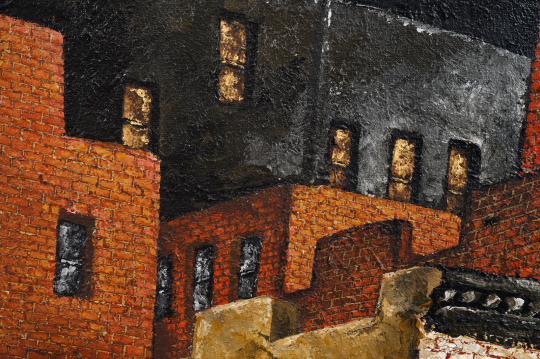


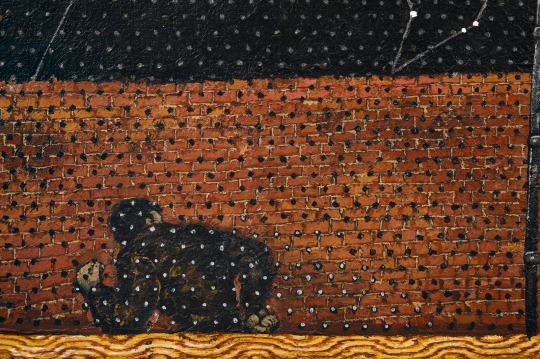

Martin Wong
(American, 1946-1999)
Persuit (El Que Gane Pierde - He Who Wins Looses), 1984,
Hindman Auction
Martin Wong was born in Portland, Oregon in 1946 and came of age artistically in the heady California dreamscape of late 1960s San Francisco. Living in the Haight-Ashbury neighborhood of Merry Pranksters and Grateful Dead infamy, Wong an openly gay man of Chinese ancestry, found acceptance in the free spirited, open-minded and mind expansive ideologies of the hippie lifestyle, while experimenting creatively in ceramic and performance art. Above all a painter, it was Wong’s works in the second dimension that earned him the most recognition in the Bay Area and the fabled handle Human Instamatic for his facility for cranking out $7.50 portraits at street art fairs and communal happenings.
In 1978 Wong switched coasts, moving to New York’s Lower East Side, mythically on a friendly “if you can make it there…” type dare, to forge his path as an artist in the postpunk, postmodern epicenter of culture and cool. In New York Wong focused his creative energy on painting using his representation talents to compose edgy, enigmatic and existential character studies of the city, its denizens, buildings, bricks, concrete, steel and pavement, primarily limiting this raw documentation to the sourced sights and sites of his immediate neighborhood. For the most part a self-taught painter, Wong’s canvases identifiably have a naïve visionary quality, sensitively balancing fantastic wonder with observed reality, paint handling imbued with an overall haunting sense of longing, that seems to explore what it means to belong to a group. An artists’ artist, Wong established himself as fixture on the Low East Side art scene, supporting his passion for paint with a day job at the MOMA giftshop, also picking and flipping undervalued antiquities at auction to make ends meet. Just as he enjoyed fellowship with the dropped-out freaks in Frisco, Wong connected deeply with the emerging east coast underground culture of hip hop, specifically the graffiti element, importantly co-founding the Museum of American Graffiti in 1989 and generously donating his own impressive collection of artworks by graffiti pioneers to the Museum of the City of New York in 1994. Wong joined forces romantically and creatively with Nuyorican underground poet and playwright Miguel Piñero after the two met at an exhibition opening at alternative project space ABC No Rio in 1982. The pair’s time together was inspired and productive, with Wong creating many of his most innovative and accomplished painting during their partnership, culminating in Wong’s ambitious 1984 solo show Urban Landscapes at the taste making Semaphore Gallery.
Painted in these salad days and acquired at Semaphore the year it was painted, Persuit (El Que Gane Pierde - He Who Wins Looses), 1984, is a self-consciously ominous New York nocturne, a surprisingly illusionistic wooden frame peppered with poetic phrasing, presumably words burrowed from his often collaborator Piñero, borders a clue that sleight-of-hand could be at play, a view finder, capturing and celebrating this authentically gritty New York minute. In his signature uncommon social meets magical realist fashion, Wong gracefully champions the underdog, the underrepresented, the unseen, revealing the unique and flawed glory of these ignored individuals, also the components that comprises the greater structural whole of an equally marred and magnificent metropolis. A comfortable insider to outsider or even outlaw company, Wong plays with this captivating contradiction visually and conceptually, arranging the composition with gorgeously detailed barriers and boundaries of crumbling brick facades, confining fences, locked gates and closed doors, challenging the audience to uneasily decide which side of the conflict or tracks they reside on, are you a part of, or apart from. In the lower left corner of Persuit…, a shadowy figure ambiguously give chase as loser or be chased as winner, either on the Ignatz Mouse or the Krazy Kat end of the brick toss, depending on the viewer’s chosen vantage, voyeur of the locked in or witness to the locked out. The phrase El Que Gane Pierde, which translates to the antagonistic Whoever Wins Loses also emphatically appears in the charged closing scene of Piñero’s 1984 play Short Eyes, loosely about his incarceration experience, lending credence to a potential jailbreak read of the subject’s trajectory. The lone actor blends with his staged surroundings, partially obscured by the stylized grid of a chain link fence, dwarfed by a desolate righthand crowded backdrop of apartment building geometry, obsessively rendered with Wong’s hallmark exposed brick motifs, enduring monuments of urban progress, a somber stoic chorus more than scenery. Overhead a cryptic surreal constellation map, a visual language of pattern parallel to the fingerspelling iconography the artist frequently employed, stands in as night sky accentuating the intoxicating mystery of the foreboding narrative unfolding. This carefully articulated and decisively stylized star chart dually provides shelter of darkness and celestial navigation guiding our hero hopefully to an escape of transcendent negating outcome, the sublime symbolism of the draw.
Wong sadly lost his battle with AIDS in 1999, dying from complications of the illness years prior to his work receiving the universal acclaim it earns today. Always painstaking in the organization of his vision, following being diagnosed in 1994 Wong was able to realize his full body of work to a level of completion he felt resolved, satisfyingly defining his own destiny as that of a lasting legacy of artistic wins.
18 notes
·
View notes
Photo
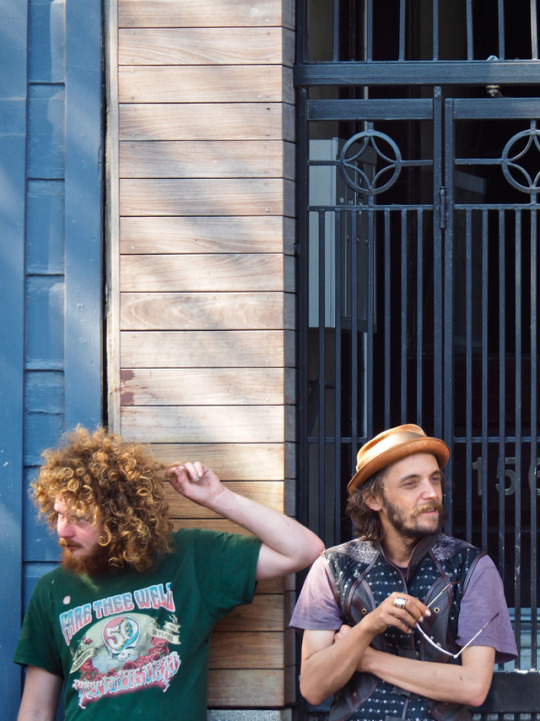
Haight-Ashbury | San Francisco
#haight ashbury#san francisco#people#portrait#street#street photography#candid photography#travel#california#travel blog#travel photography#original photographers#original photography blog#original photography on tumblr#lenblr#self portrait#photographers on tumblr#yourheartisbeating
2 notes
·
View notes
Text
A Time of Youth
San Francisco, 1966–1967

A year before 1967's famed Summer of Love, documentary photographer William Gedney set out for San Francisco on a Guggenheim Fellowship to record “aspects of our culture which I believe significant and which I hope will become, in time, part of the visual record of American history.” A Time of Youth brings together eighty-seven of the more than two thousand photographs Gedney took in San Francisco's Haight-Ashbury neighborhood between October 1966 and January 1967. In these photographs Gedney documents the restless and intertwined lives of the disenchanted youth who flocked to what became the epicenter of 1960s counterculture. Gedney lived among these young people in their communal homes, where he captured the intimate and varied contours of everyday life: solitude and companionship, joyous celebration and somber quiet, cramped rooms and spacious parks, recreation and contemplation. In these images Gedney presents a portrait of a San Francisco counterculture that complicates popular depictions of late 1960s youth as carefree flower children. The book also includes facsimiles of handwritten descriptions of the scenes Gedney photographed, his thoughts on organizing the book, and other ephemera.
Gedney arrives in San Francisco full of hope and optimism, determined to closely observe these young people, barely adults, who are looking for a happiness different from that suggested by American consumer society. It is towards a group of hippies that he will turn his gaze, a community living in a place nicknamed The Pad
5 notes
·
View notes
Text
Beth Elliott
Beth Elliott is an American folk musician who was an active and prolific contributor to the artistic lesbian separatist scenes of the West Coast in the 1970s. Facing rejection from her parents when she came out as a trans woman, she left home at nineteen to find a new home with the Daughters of Bilitis, the syndicate oft cited as the first major lesbian civil and political rights organization. Here, Elliott not only found community, but rose to prominence when elected as vice-president of the chapter in DOB’s founding city, San Francisco, after being asked to run.[1] Of her time with the Daughters, she wrote:
"We were witnessing the emergence of an incredibly diverse group of women . . . suddenly, we could explore what we wanted, how we wanted to live together, what kind of community we could grow . . . . Our lives were about love, beautiful sexual expression, poetry, art, music, and reveling in being women . . . loving other women . . . . It was a very sweet time, a time in crazy and overly idealistic synch with the rest of the counterculture, and a time when many of us truly did care about each other as sisters."[2]
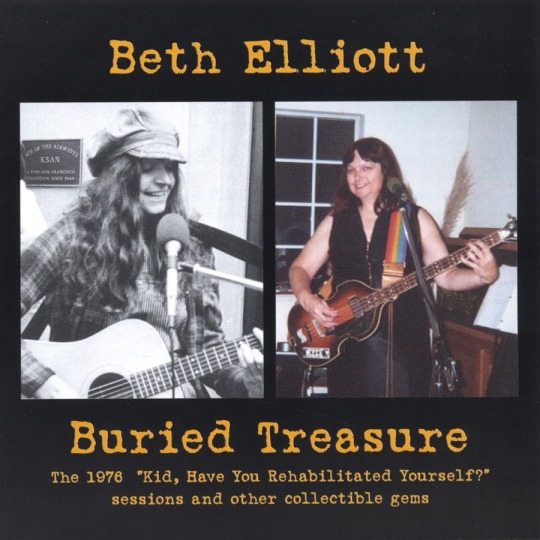
Beth Elliott performing, then and now; the cover of her 2005 compilation, Buried Treasure.
Like other members of DOB, Beth was embraced for her affirmation of lesbian and feminist lives, and her willingness to risk herself in embracing this life. She also helped contribute to feminist critiques of normative and dominant forms of medicine, through which Elliott encountered a great deal of transphobic, misogynist, and homophobic oppression in her struggles to receive gender-affirming care.
The same year she left home, Beth attended the 1971 Gay Women’s Conference in Los Angeles, where she found refuge with the “fun-loving cadre known as the Orange County Dyke Patrol, as well as the women from the LA chapters of DOB”.[3] Of this conference, Elliott wrote: “Where others were deadly serious about finding the correct feminist political line, we had words of wisdom from the Orange County Radical Lesbian Feminists . . . ‘If it’s worth doing, it’s worth doing with joy.’”[4]
The LA organizers of the conference “loved Beth for her artistic talents and wicked sense of humor”[5] and she was invited to plan a follow-up conference in 1973. Unfortunately, this conference would become a transphobic flashpoint in dominant histories of feminism when Elliott’s inclusion in the conference was put to a vote in a violent and dehumanizing disruption of one of her musical performances.[6] Beth was flattened into an “issue,” a flashpoint for transphobic over what constitutes one’s belonging to the categories of woman, feminist, and lesbian. Elliott had the chance to respond to this situation and the subsequent transphobic keynote address that ensued at the conference, in an article published in The Lesbian Tide, a paper for which she had acted as a San Francisco correspondent for some time. You can read the original article, in which she argues against a number of transphobic arguments that, regrettably, continue to circulate to this day, here.[8]
Well-loved for her passion, humour, and heart, Beth Elliott’s story reaches far beyond this dehumanizing flashpoint. She made significant contributions to the worlds of both music and literature. Active in the Haight-Ashbury music scene producing psychedelic and folk rock in 1970s San Francisco, Beth’s songs often explicitly took up the struggles of the feminist movements in which she was involved, as in her prototypically folksy “Ballad of the Oklahoma Women’s Liberation Front,” which you can listen to here. She also has her share of lesbian heartbreak ballads, as well as lighthearted and wistful folk-bops like “Teen Love” and “Rubyfruit Jungle.” Though her discography or involvement in musical groups is hard to trace online, there is no doubt that Elliott was a prolific member of the feminist and lesbian political communities of which she was a part largely because of her musical contributions to these movements, playing countless shows at protests and conferences like the 1971 Gay Women’s Conference. She released a compilation of her best-loved music from a number of sessions she recorded in 1976, in addition to a handful of others, in 2005, entitled “Buried Treasure.” Her 1996 memoir, Mirrors: Portraits of a Lesbian Transsexual, has been lauded as a classic in feminist and trans literary histories. Though she is now retired, Beth Elliott’s story continues to be extrapolated in wider public histories, embracing her increasingly as a foremother of feminist, lesbian, and trans political struggles and an icon of folk music in its classic, politically-motivated form.
SOURCES
[1] Finn Enke, “Collective Memory and the Transfeminist 1970s: Toward a Less Plausible History,” TSQ: Transgender Studies Quarterly 5 (1): 14.
[2] Beth Elliott, qtd. in Ibid., 14.
[3] Ibid., 15.
[4] Beth Elliott, qtd. in Ibid., 15.
[5] Ibid., 16.
[6] Ibid., 16-17.
[7] The Berkeley Revolution, https://revolution.berkeley.edu/of-infidels-and-inquisitions/?cat=439&subcat=5/.
[8] Beth Elliott, “Of Infidels and Inquisitions,” The Lesbian Tide, June 1973: 15, 26, https://revolution.berkeley.edu/assets/Beth-Elliot-on-WCLC-full.png/.
14 notes
·
View notes
Text
california gothic
inspired by this post
Looming about the morning skies is thick dense fog, particularly heavy around the San Francisco Bay Area, but prevalent along the coastline from San Diego all the way up to Crescent City. It straddles the land and leaves a frigid damp feeling in its wake even upon clearing out with the afternoon sun.
further inland is a phenomenon known as “tule fog”, brought on by the cold night air caressing over the sun-baked earth. This fog is thick, often so thick that it warrants a warning to use caution driving anywhere in Bakersfield and Fresno.
At night after the fog has collected and compounded into thick piles in the valleys within the Sierra Nevadas and the Santa Lucias, it’s quiet. So quiet that the possibility of madness runs high.
the small towns scattered about the rural parts of the state roll up their sidewalks at sundown, no exceptions, no matter what the time of year.
the small towns all either have these weirdly matter-of-fact names like “Baker”, “Monolith”, and “Obsidian”, indigenous names like “Tehachapi”, or they’re named after people like “Taft” and “Delano”. It’s here that you realize there’s three tiers of society here.
the Central Valley is utterly littered with rusty old oil rigs and people who aren’t exactly “there” so to speak. Their grandparents and great-grandparents originally hailed from Tornado Alley in the wake of the Dust Bowl. This is rather common near the Bakersfield area, which consists of said oil rigs and farmland.
Figure there must be a hidden plantation at some point near the Arvin area. The farm workers are trying to escape and expose the corruption of the owner while offering you strawberries and avocados for prices you can’t beat with a stick because the other alternative is to let them starve at the hand of the owner.
The times it snows leave the mountainous areas in thick blankets of pure white. You arrive in a place such as Squaw Valley or Big Bear or Mammoth with your parka, skis, knee high boots, and goggles because the other alternative is literally freezing under Devil’s Postpile. You stay in the lodge during your break where you are nestled down in the comfiest chair next to a roaring fire and with a cup of hot cocoa in hand. You watch the snow falling in silence outside the large bay window.
every other street in Los Angeles is one way. If you miss your turn, there’s no way back.
the upper class in LA is well-to-do, parading about with their sexy carriages and living within their elaborate houses surrounded by lush yards and above ground swimming pools. One can only wonder about the lives of the beautiful people as their maid staff appears more downtrodden than the farm workers.
Graffiti tags and murals are everywhere, vast stretches of elaborate, gratuitous paintings sprayed and scribed onto the pale bricks making up the skyscrapers near the heart of downtown. Works range from thick word art of all colors of the rainbow made brighter by the neon street lights, to haunting portraits that follow you onto Sepulveda Boulevard or into the nearby 7-11.
Every gutter is either incredibly filthy or flooded. Every street is either poorly maintained or just been paved. Freeways are a delicate intricate web embedded amongst the city of angels like veins. A wrong turn and you’re on your way to Riverside.
San Francisco is pristine with its clean lines and bleached underpants. Art is the city’s lifeblood even with its insistence on geometry. It flows like a river in the spirit of Haight-Ashbury like a psychedelic lick under the cluster of glass and clean steel. You feel it upon the walkway of the Golden Gate Bridge and the cold kiss of the Bay fog.
San Diego relaxes like a napping cat, under the Pacific sun while straddling the brim of the low desert and the Mexican border. You walk about any street under a jacaranda tree and the first passerby will give you directions to La Hoya on a whim. The kindness perturbs you to where you wonder if these people have been programmed to bestow kindness unto humans.
Little Italy is voluptuous and alluring: quaint cafes are the norm, gentle colors welcome you and call you bellissima; meanwhile, the aroma of fresh tomatoes seduces you to that big bowl of gorgeous pasta and leaves you feeling full and lush, much like the slender, very sexy, very mysterious Italian Stallion seated outside with his shirt collar opened, his hand on the cup of latte, and his eye on both you and the young lady with a round full figure.
Wine country dials the sensuality back but the stacks of barrels near the vineyards signify business owners with a lot to say but no one to say to because everyone they have said it to has already heard it.
Northern California carries a veil reminiscent of upstate New York around it. Sacramento remains low-key even in the wake of a devastating wildfire and a dirty, dingy downtown area. The forests and the highway are near-untouched, vast and grassy under the unsettlingly quiet Mount Shasta and the cold, menacing Mount Lassen. The towns are nondescript but oft closed to visitors. Puritans so abound, they either dismiss you or want to brainwash you.
The eastern Sierra is even more deceitful, the high mountains and passes changing weather within thirty minutes after the fact. You might freeze outside of Bridgeport or on Tioga Pass en route to Yosemite. That is if you don’t fall in and dissolve at the helm of the alkaline Mono Lake.
The Mojave is vast and desolate, beginning in a bowl shape at the base of Long Valley Caldera and stretching into a long wind tunnel along the jagged foreboding eastern Sierra, and falling into cold windswept darkness after the hour hand hits the two. Beyond that it disappears into the distance under the bath of the sun, an enormous sheet of scorched earth scattered with volcanic rock, Joshua trees, and sagebrush. Darkness rides into the sinking grave of Death Valley at high noon.
Volcanic activity is understated but present, looming in the background like a demon, the sole barrier between you and it being boulders as thick as skyscrapers. That hairline fracture? Probably nothing. Hopefully.
The ocean is cold and gray before every beach. Some beaches have sand, others are steep cliffs, others with smoothed sea glass, fragments of bottles and cans left to waste, tumbled and transformed into colorful art by the alchemical caress of the sea.
Seaweed, shells, and driftwood are an unsung currency. It’s not uncommon to find yourself draped in a batch of kelp following a storm surge near Point Conception. You might as well be rich at that point.
Palm trees rise up against the cold fog, oftentimes juxtaposed to a jacaranda or a ponderosa pine. Or both. Either way you find yourself lost.
One gets a vibe that the Spanish missions of the 19th century instilled a fear of God and the apocalypse into everyone. Don’t be surprised if you’re walking near the Hollywood sign and you feel the ground rumble beneath your feet. The San Andreas fault is never far away.
52 notes
·
View notes
Photo

TOMORROW, Saturday, January 21 at 3 PM, @deborahbellphotographs presents a conversation with photographer Elaine Mayes and editor Kevin Moore about the exhibition and @damiani_books publication, 'The Haight-Ashbury Portraits 1967–1968.' Reception and book signing to follow. Deborah Bell Photographs 526 West 26th Street, Room 411 New York, NY 10001 Phone: 212.249.9400 Email: [email protected] #elainemayes @elainemayesphoto @fultonstreet #haightashbury https://www.instagram.com/p/CnpdaNDJRTV/?igshid=NGJjMDIxMWI=
0 notes
